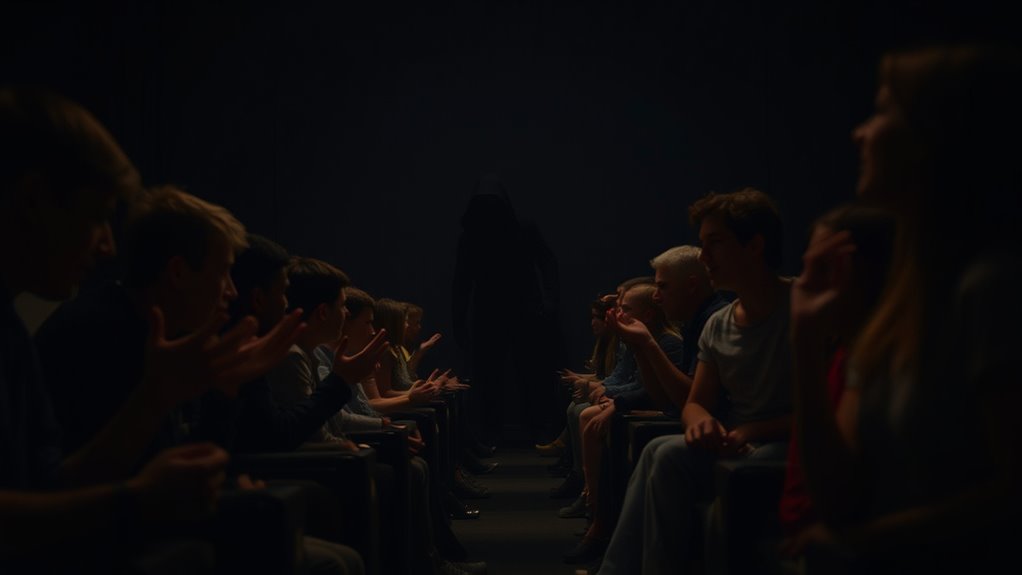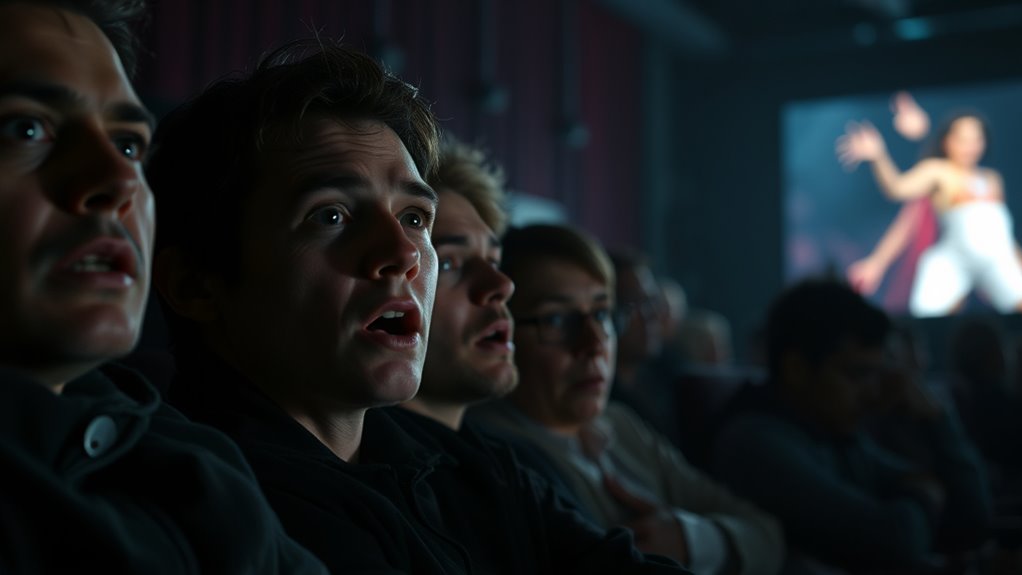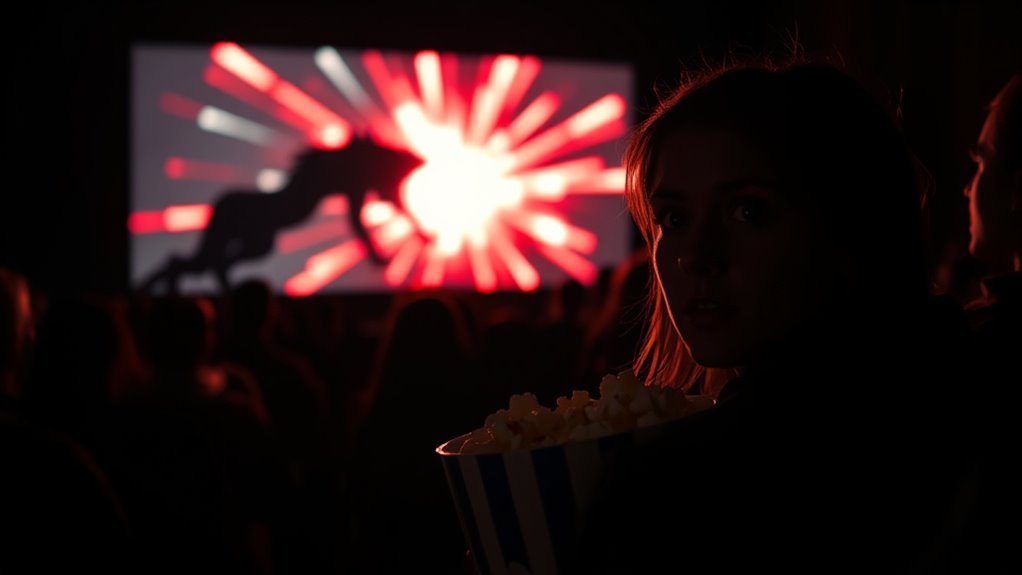When you watch a horror movie, your brain reacts quickly to sudden sounds and visuals, activating the amygdala and sparking the fight-or-flight response. Surprising scenes disrupt your expectations, maximizing shock and tension. Sharp sounds, stark lighting, and repeated scares keep you engaged by triggering primal instincts and conditioning your reactions. If you want to understand how filmmakers master this psychological pull, exploring further will reveal the secrets behind making scares unforgettable.
Key Takeaways
- Jump scares trigger the brain’s fight-or-flight response, releasing adrenaline that heightens alertness and physical reactions.
- Unexpected stimuli disrupt expectations, amplifying shock through rapid neural responses and contrast with anticipation.
- Sudden sounds and visual cues activate primal instincts, intensifying fear and immersion in the scene.
- Repetition of scares conditions viewers to associate cues with fear, creating long-term psychological responses.
- The combination of surprise, suspense, and sensory stimulation keeps viewers engaged and eager for more scares.
The Brain’s Response to Sudden Stimuli

When you encounter a sudden noise or movement, your brain quickly detects the unexpected stimulus and triggers a rapid response. This process involves neural pathways that swiftly relay information from your senses to your brain’s threat perception centers. These pathways are specialized for speed, allowing you to react almost instantly. When the brain perceives a threat, it activates the amygdala, which heightens alertness and prepares your body for action. This quick response is essential for survival, helping you avoid danger. The neural pathways involved in threat perception are finely tuned, so even minor sudden stimuli can set off this alarm system. Your brain’s ability to rapidly interpret and respond to these stimuli is what makes jump scares so effective—they tap into this primal, automatic reaction. Incorporating a basic understanding of the brain’s response to stimuli can help explain why horror movies are so compelling.
The Role of Surprise and Expectation

Surprise plays a crucial role in the effectiveness of jump scares because it disrupts your expectations and catches you off guard. This taps into the anticipation paradox, where your brain’s desire for predictability makes sudden surprises more startling. Before the scare, filmmakers often build suspense through a suspense buildup, creating a tense atmosphere that heightens your anticipation. When the unexpected happens, it clashes sharply with your expectations, triggering a rapid neural response. This contrast between what you expect and what actually occurs amplifies the shock, making the jump scare more memorable. Fundamentally, your brain is wired to respond intensely to violations of anticipation, which is why surprise is such a powerful tool in horror movies. It keeps you engaged and on edge, keen for the next unexpected moment. Additionally, using aesthetic visual cues in cinematography can enhance the impact of the surprise, making the scare even more visceral.
Emotional Arousal and the Fight-or-Flight Reaction

Emotional arousal intensifies your physical response to a jump scare by triggering the fight-or-flight mechanism, which prepares your body to confront or escape perceived danger. When you experience a jump scare, your brain signals the release of adrenaline, causing an adrenaline rush that heightens your senses and quickens your heartbeat. This surge of emotional arousal makes you feel alert, tense, and ready to react. To illustrate, consider the following:
| Emotional State | Physical Response | Resulting Feeling |
|---|---|---|
| Fear | Rapid heartbeat | Anxiety or panic |
| Surprise | Dilated pupils | Increased alertness |
| Shock | Muscle tension | Immediate focus |
This interplay keeps you hooked, as your body is constantly prepared for the next fright. Additionally, the contrast ratio of a display can influence how effectively these scary moments are perceived, making the scene appear more vivid and immersive.
How Sound and Visual Cues Amplify Fear

Sound and visual cues are powerful tools that heighten your fear response during a jump scare. Sudden, sharp sounds like a jarring music tension create an immediate sense of alarm, triggering your fight-or-flight instinct. These sounds often synchronize with visual cues, such as a stark visual contrast between dark shadows and bright highlights, which draws your eye and increases tension. The abrupt change in lighting or unexpected movement amplifies your sense of danger, making the scare more intense. By combining unsettling sounds with striking visuals, filmmakers tap into your primal instincts, making you more likely to jump or feel anxious. Additionally, the use of lighting requirements and strategic sound placement can enhance this effect, heightening emotional engagement and making the scene more memorable. This strategic use of sound and visual cues keeps you engaged and heightens the emotional impact of the scene.
The Psychological Appeal of Repeated Scares

Repeated scares in horror films or stories play on your mind long after the scene ends, creating a pattern that keeps you hooked. This relies on psychological conditioning, where your brain associates certain cues with fear, making future scares more effective. The suspense buildup heightens this effect, steadily increasing tension before the jump scare hits. Repeating these scares reinforces this pattern, making your emotional response almost automatic. Visual and auditory cues become familiar triggers, intensifying your reactions over time. Imagine a scene like this:
| Calm scene | Sudden noise | Fear response | Return to calm |
|---|---|---|---|
| Quiet hallway | Creaking door | Heart pounding | Silence |
| Normal day | Shadows flicker | Anxiety spikes | Relief |
| Friendly face | Ominous sound | Jump scare | Relaxation |
This cycle keeps you engaged, craving the next thrill. Recognizing how fear conditioning shapes your reactions can help you understand why horror movies are so effective at keeping you captivated.
Frequently Asked Questions
How Do Individual Differences Affect Jump-Scare Sensitivity?
Your personality traits and prior experiences shape how sensitive you are to jump-scares. If you’re naturally more anxious or thrill-seeking, you might react strongly, jumping more often or feeling more fear. Past encounters with scary movies or real-life fright also influence your response. So, your individual differences make some people more easily startled, while others stay calm, affecting how intensely you experience jump-scares in horror films.
Can Repeated Scares Diminish or Enhance Fear Response Over Time?
Think of your fear response as a fire—repetition fatigue can cool it down, making scares less intense over time. Repeated scares might diminish your emotional resilience, causing you to become numb or less affected. However, for some, repeated exposure can actually strengthen their fear response, like building emotional muscles. So, whether fear diminishes or enhances depends on your individual sensitivity and how your emotional resilience adapts to the scares.
What Neurological Pathways Are Involved in Processing Horror Stimuli?
When you see horror stimuli, your brain activates the amygdala, triggering fear responses. This activation releases dopamine, creating a sense of thrill and excitement. Your brain’s neural pathways involve the amygdala, which processes emotional reactions, and the reward system that releases dopamine to reinforce the experience. This combination keeps you engaged, heightening your emotional response and making horror movies both terrifying and addictive.
Do Cultural Factors Influence Reactions to Jump-Scares?
Did you know that cultural perception considerably impacts how you react to jump-scares? Your societal norms shape what you find frightening or shocking. For example, a jump-scare in a horror film might terrify someone from one culture but barely faze someone from another. Your reactions are deeply influenced by cultural background, which determines what’s considered taboo or frightening, making your experience of horror uniquely personal yet culturally shaped.
How Does Anticipation Heighten the Effectiveness of Jump-Scares?
Anticipation heightens the effectiveness of jump-scares by amplifying your psychological effects, making the surprise feel more intense. When filmmakers use cinematic techniques like suspenseful music and pacing, they build tension that primes you for a scare. This heightened state makes your reaction more visceral, as your mind is on edge, ready for the unexpected. Ultimately, anticipation turns a simple jump-scare into a powerful emotional experience.
Conclusion
Understanding the science behind jump-scares reveals why they keep you hooked—your brain craves that adrenaline rush and the thrill of the unexpected. As you jump at sudden sounds or shadows, you’re riding the edge of your comfort zone, chasing that fleeting high. It’s a classic case of “curiosity killed the cat,” but in this case, it’s the adrenaline that keeps you going back for more, craving that adrenaline-fueled thrill only horror movies can deliver.









